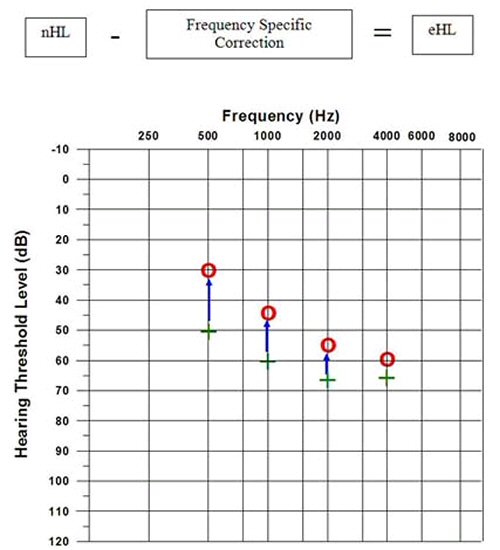Question
Can auditory brainstem response (ABR) threshold estimates be used in hearing aid fitting? It is my understanding that a correction is needed. How do I know if an ABR system has a correction in it and if so, how are they applied.
Answer
Thanks for the question, we will answer this in three parts:
How are auditory brainstem response (ABR) threshold estimates used in hearing aid fitting?
It is possible to prescribe and fit a hearing aid to a young infant based on data obtained from an ABR assessment. However, it should be noted that the thresholds estimated from the ABR are typically higher when compared to behavioral thresholds. In fact, they can be as much as 20 to 30 dB higher, depending on the frequency (Stapells, Gravel, & Martin, 1995; Stapells, 2000). This is a significant difference in terms of intervention. Therefore, a correction is applied to the ABR threshold estimates to better predict the behavioral threshold. This corrected ABR is sometimes referred to as Estimated Hearing Level (eHL) to distinguish it from a typical ABR referenced in Normalized Hearing Level (nHL). Some ABR systems have the correction embedded in as part of its calibration. For those that do not, a correction must be applied prior to calculating the hearing aid prescription.
How do I know if the ABR system has the correction embedded in it?
Unless the corrected ABR data from the system has a reference other than nHL (i.e. eHL or HL), there is no clear way to determine if the correction has been embedded into the system's calibration. If the clinician fitting the hearing aid has not conducted the ABR, it is important to communicate with the clinician who conducted the ABR to determine what type of data the ABR system is producing (i.e. HL, eHL, or nHL). If the clinician who performed the ABR is also doing the fitting, a conversation with the person who calibrated the ABR system is needed. With either scenario, it is important to know whether the correction has been applied or not. Given the large value of the correction, it is crucial that it be applied, and only once. Under- or over-amplification can result if the correction is applied twice or not at all. Therefore, it is ultimately the clinician's responsibility to understand what type of data the ABR system is producing in order to determine if a correction is required.
How are the corrections applied to the ABR values?
The frequency-specific corrections are subtracted from the ABR values. Since previous research has shown that ABR threshold estimates (nHL) are typically higher than behavioral thresholds (HL), the correction value is subtracted to provide a better estimate of behavioral thresholds (eHL) for the purposes of hearing instrument fitting. The schematic in Figure 1 describes this calculation, which is also represented on the accompanying audiogram.

Figure 1. Schematic of correction factors applied to ABR (nHL) threshold data to estimate behavioral thresholds for the purpose of hearing aid fitting. On the audiogram, the green plus signs indicate the ABR threshold value in nHL, and the red circles indicate the corrected value in eHL. It is important to note that the subtracted corrections improve the initial thresholds estimated by the ABR.
The correction values are frequency-specific and are impacted by how the ABR system is calibrated, as well as the stimulus and collection parameters used. For some prescriptive algorithms (i.e. DSL m[i/o] v5), the clinician can 1) enter data in nHL and a default correction will be applied, 2) enter data in nHL and apply clinic-specific corrections, or 3) enter the data in eHL. The third method assumes that a correction has already been applied and the algorithm will not apply one. For more information on how these data are used in DSL m[i/o] v5, refer to Bagatto, et al., 2005.
This Ask The Expert Question was taken from an article previous published on Audiology Online entitled, "Learning the Art to Apply the Science: Common Questions Related to Pediatric Hearing Instrument Fitting". See Bagatto and Moodie (2007) for additional information.
References
Bagatto, M., Moodie, S., (2007, October 8). Learning the Art to Apply the Science: Common Questions Related to Pediatric Hearing Instrument Fitting. Audiology Online, Article 1886. Accessed from the Article Archives from www.audiologyonline.com/articles
Bagatto, M., Moodie, S., Scollie, S., Seewald, R., Moodie, K., Pumford, J., & Liu, R. (2005). Clinical protocols for hearing instrument fitting in the Desired Sensation Level Method. Trends in Amplification, 9(4), 199-226.
Stapells, D.R. (2000). Threshold estimation by the tone-evoked auditory brainstem response: a literature meta-analysis. Journal of Speech-Language Pathology and Audiology, 24(2), 74-83.
Stapells, D.R., Gravel, J.S., & Martin, B.A. (1995). Thresholds for auditory brain stem responses to tones in notched noise from infants and young children with normal hearing or sensorineural hearing loss. Ear and Hearing, 16(4), 361-371.
Marlene Bagatto, Au.D., is a Research Associate and Sheila T. F. Moodie, M.Cl.Sc., is a Research Audiologist at the National Centre for Audiology at the University of Western Ontario in London, Ontario, Canada.

